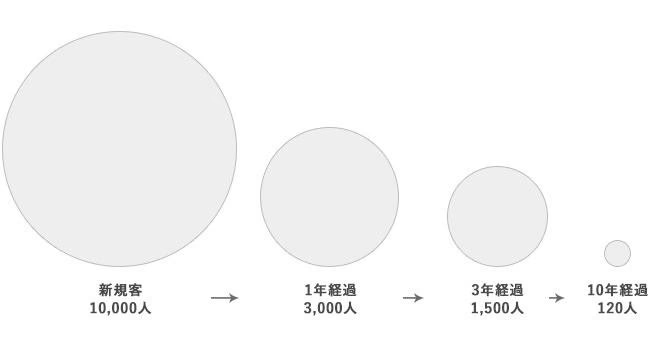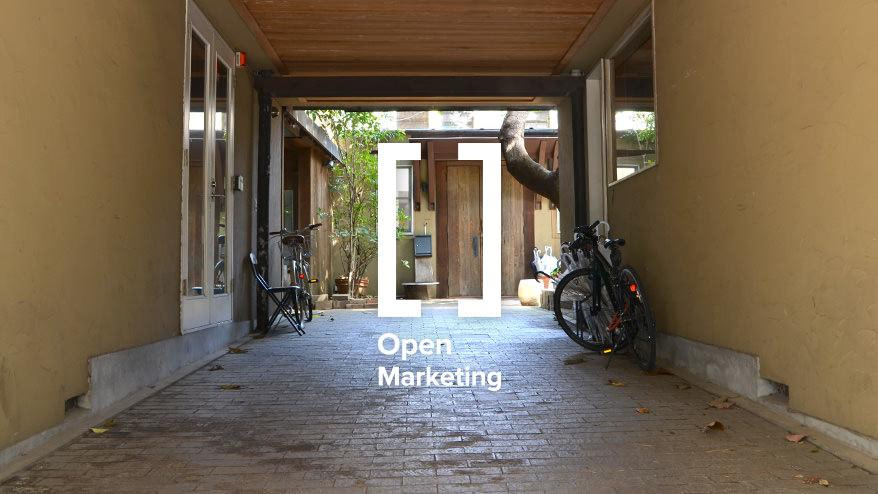Hello everyone. I am Hayashi, the representative of Monosus.
Last time , we looked at Open Marketing from a quantitative perspective.
We examined why marketers are constantly striving to acquire new customers.
This is the sixth installment of the series, and we will continue to delve deeper into how the system that is constantly striving to attract new customers is created.
Let's consider the challenges of the existing marketing model.
Mechanism behind the slowdown in new customers
First, continuing from last time, let's analyze the customer population structure a little more.
Below is the trend table of customer numbers, which we introduced last time.
| year | Number of customers | Number of customers who have been with us for 3 years or more | Number of customers who have been with us for 5 years or more |
| Year 1 | 10,000 people | 0 people | 0 people |
| Second Year | 13,000 people | 0 people | 0 people |
| Third Year | 15,100 people | 0 people | 0 people |
| Year 4 | 16,570 people | 1,470 people | 0 people |
| Year 5 | 17,599 people | 2,499 people | 0 people |
| 6th year | 18,319 people | 3,219 people | 720 people |
| Year 7 | 18,824 people | 3,724 people | 1,225 people |
| Year 8 | 19,176 people | 4,076 people | 1,577 people |
| Year 9 | 19,424 people | 4,324 people | 1,825 people |
| 10th year | 19,596 people | 4,496 people | 1,997 people |
The conditions are the same as last time: acquire 10,000 new customers every year from the first year to the tenth year.
If the retention rate for the second year is 30% and the retention rate for the third year and onwards is 70% and the business continues
This is the change in the number of customers over a 10-year period.
(The number of customers here refers to the number of customers who have made a purchase at least once in that year.)
The main points I mentioned last time
- The number of customers steadily increased until the fifth year.
- However, after the sixth year, growth slowed down and there was almost no growth thereafter.
- In addition, the number of customers who have been with the company for three or more years also starts to grow at a slower rate after the eighth year.
- Even in the 10th year, new customers still account for half of the customer base
That's what it was.
So why is customer growth slowing?
This can actually be expressed by a very simple formula.
Because the formula to calculate the number of customers per year is, under the condition that the number of new customers and the repeat rate are constant,
Number of customers = Number of customers from previous year + Number of remaining customers from first year
Because it is required by.
To explain it in a simpler way, it can be expressed in the following table:
| Number of customers | New Customers | Number of remaining customers for 1 year | 2-year remaining customer numbers | 3-year remaining customer numbers | Number of remaining customers in 4 years | |
| Year 1 | 10,000 people | 10,000 people | ||||
| Second Year | 13,000 people | 10,000 people | 3,000 people | |||
| Third Year | 15,100 people | 10,000 people | 3,000 people | 2,100 people | ||
| Year 4 | 16,570 people | 10,000 people | 3,000 people | 2,100 people | 1,470 people | |
| Year 5 | 17,599 people | 10,000 people | 3,000 people | 2,100 people | 1,470 people | 1,029 people |
The "number of customers" shaded in blue is the "number of customers in the previous year" and
We can see that this is the sum of the "remaining number of customers from the first year" (the red shaded area) that remain in that year.
The number of customers in the second year will be 13,000, which is the sum of the number of customers from the previous year (10,000) and the number of remaining customers from the first year (3,000) remaining in that year.
The number of customers in the second year is 15,100, which is the sum of the number of customers from the previous year (13,000) and the number of remaining customers from the first year (2,100).
And so it increases.
In other words, the number of customers increases each year by the red shaded area (= the number of remaining customers from the first year).
In other words, even if you add 10,000 new customers every year,
The only customers you will actually gain in a given year are those that remain from the first year.
And the number remaining from the first year will naturally decrease.
As mentioned in the previous article, if the one-year retention rate is 30% and the retention rate from the second year onwards is 70%,
Ten years later, there are about 120 customers remaining.
In other words, the increase in the number of customers will be as shown in the graph below, which we introduced last time.

Customer acquisition flow diagram
We are adding 10,000 new customers every year.
The result is a slowdown in customer growth.
This is brought about by a very simple logic.
It is important to mention here that in order to reduce the number of variables, we are only discussing repeat rates.
The point is that it seems unrealistic to assume that the number of new customers acquired will be constant.
It's actually impossible.
In many cases, after a service is launched, there is an introductory period during which it hardly makes any progress.
After that, the company entered a period of growth and the number of new customers increased significantly.
It will gradually slow down and then reach its peak.
After that, it gradually becomes more difficult to acquire new customers, as shown in the life cycle.
Some require years to go from the introduction stage to the growth stage,
In recent years, some services have grown rapidly and declined rapidly.
But here's what I want you to know:
It's not about how many years a life cycle generally changes,
- Even if we could attract the same number of new customers every year,
Customer growth will inevitably slow and come to a halt - The number of new customers you acquire will not continue to grow forever.
- If the number of new customers decreases, the number of customers will decrease.
That is what it means.
When I discovered this structure, the first thing that came to mind was the problem of a declining birthrate and an aging population.
There is probably no country in the world whose population will continue to grow forever.
A period of rapid economic growth and population increase occurred simultaneously, but eventually the population began to decline due to a declining birthrate and an aging population, and the nation's power began to decline.
The problem is that, while we know that the period of high economic growth will inevitably come to an end, we are facing a declining birthrate and an aging population without taking any measures to deal with this.
In the business world, just as with the declining birthrate and aging population,
A slowdown in new customer growth is inevitable.
Nevertheless, unless we change our business structure that relies on new customers for sales,
This will force them into extremely difficult management practices.
Factorize your sales
To better understand the problems with the traditional marketing model,
I would like to add one more perspective.
The company's sales
Sales = Number of customers x Transaction frequency x Transaction amount per transaction
It can be found by the equation:
If you want annual sales,
- Number of customers: Number of customers who purchase at least once a year
- Transaction Frequency: The average number of purchases made by the above customer per year
- Transaction amount per transaction: Amount spent per purchase
This means that.
If you have 10,000 customers, the frequency of transactions is twice a year, and the amount of each transaction is 5,000 yen,
The company's annual sales are
10,000 (people) x 2 (times) x 5,000 (yen) = 100 million yen.
Earlier I mentioned that customer growth will inevitably slow down at some point.
In this case, sales will be heavily influenced by transaction frequency and the amount of each transaction.
This means that a company's performance is determined by the quality of its customers.
This is because getting the same customers to make more frequent, larger purchases improves business performance.
In other words, in order to maintain and develop a business, in the start-up phase, you need to expand your scale by acquiring new customers,
Before customer growth slows, it is necessary to increase transaction frequency and transaction value.
This means shifting management from the "quantity" of customers to the "quality" of customers .
Further factorization of customer numbers reveals
On the other hand, even though the growth in customer numbers is slowing,
There's no denying that customer numbers are a very important factor.
But there's one more thing hidden here.
The number of customers is not made up of one factor, but two.
Needless to say, these are "new customers" and "recurring customers."
By increasing the proportion of "repeated customers" among the total number of customers,
In fact, there are two benefits.
- The number of customers increases
- Increased trading frequency
That is what it means.
In order to increase the proportion of repeat customers, it is necessary to improve the repeat rate.
If this can be achieved, it will naturally lead to an increase in customer numbers.
In addition, as the proportion of repeat customers increases,
At the same time, the average transaction frequency of customers also increases.
When you think about it, this is obvious.
Furthermore, when comparing new customers with continuing customers,
Repeat customers tend to have higher transaction prices.
(This does not include services that require a large initial fee and are then repeated for maintenance purposes.)
In other words, by increasing the proportion of repeat customers,
You can improve the number of customers, the frequency of transactions, and the value of each transaction.
What to do to improve customer quality
So how can we increase the repeat visit rate necessary to increase the number of repeat customers?
I have been involved in marketing for a variety of businesses.
We have come to see what is crucially important in improving the quality of our customers' services.
it is,
Keep initial repeat visit rates as high as possible
is.
However, simply trying to increase the initial repeat rate will not produce the desired results.
Change the marketing model itself
It is important to change the structure so that it results in a higher initial repeat rate.
I'd like to wrap it up for this month.
Next month, I'd like to delve deeper into how you can change your marketing model to increase initial repeat purchase rates.
If you have any comments, opinions or questions about this article, please send them to us using the form below.

